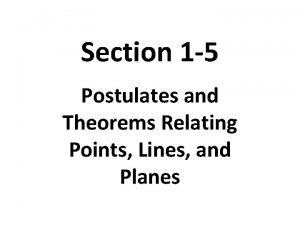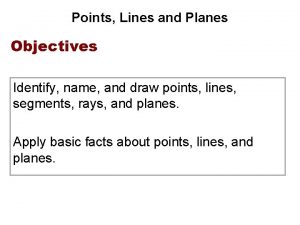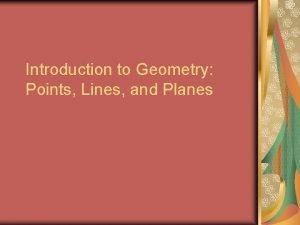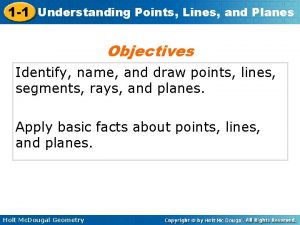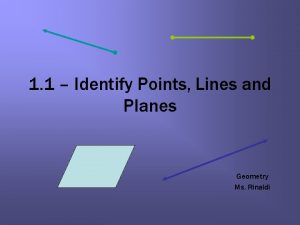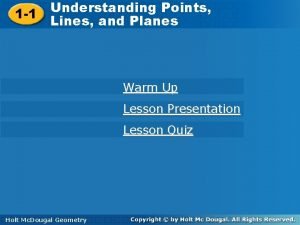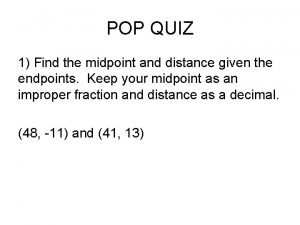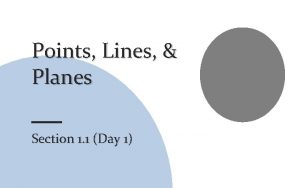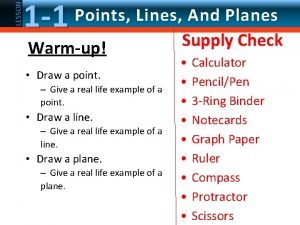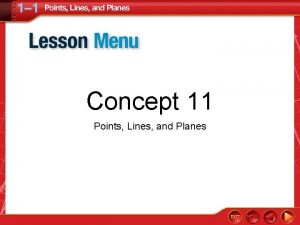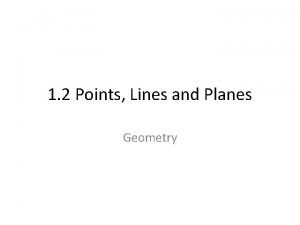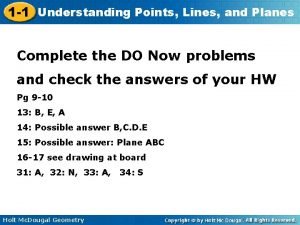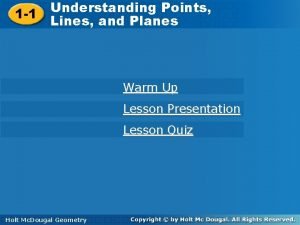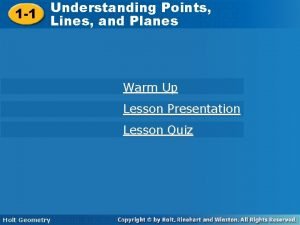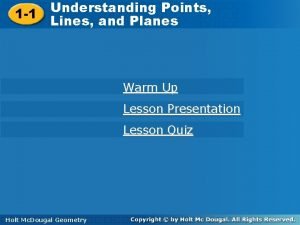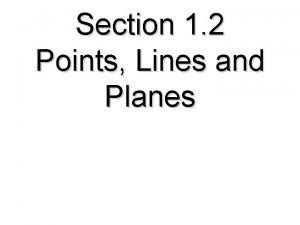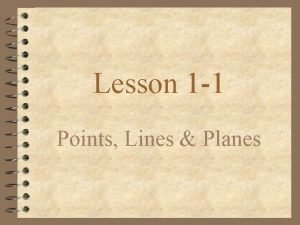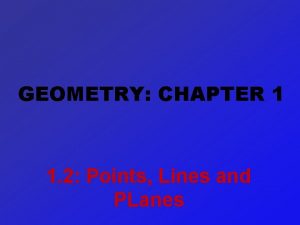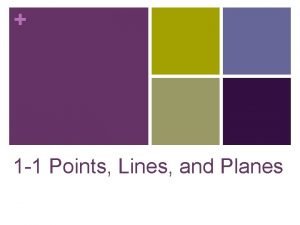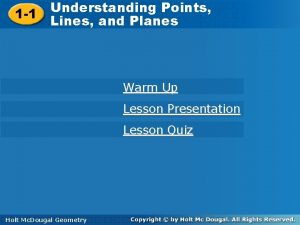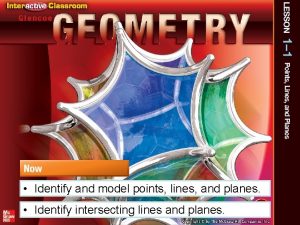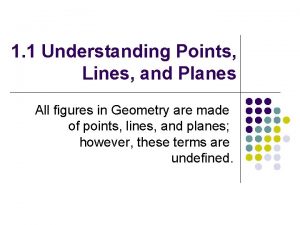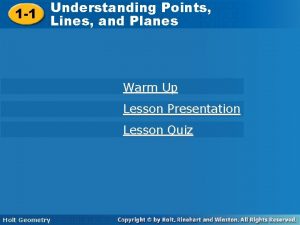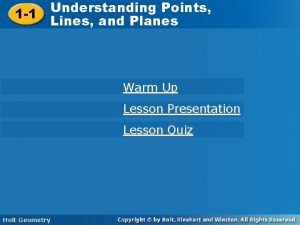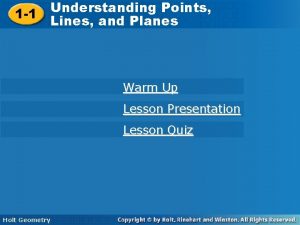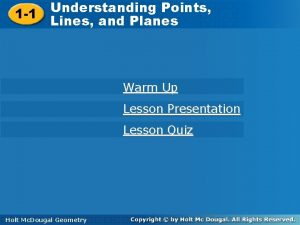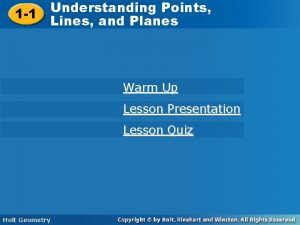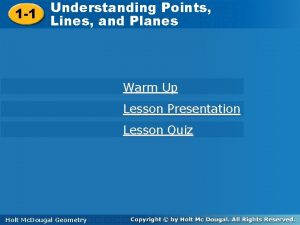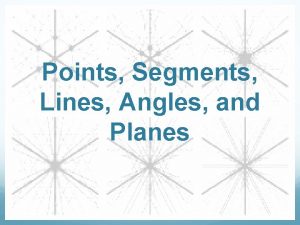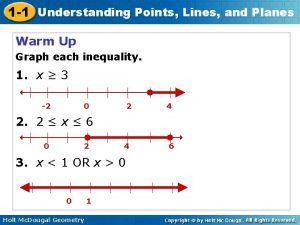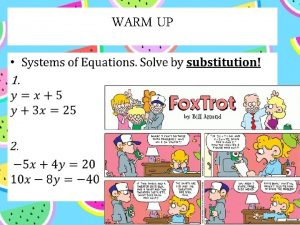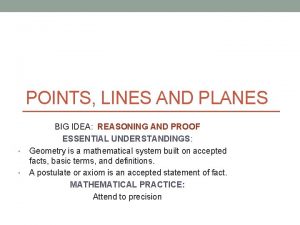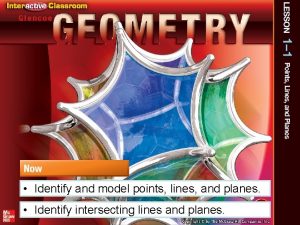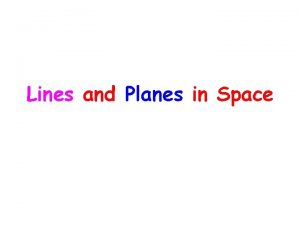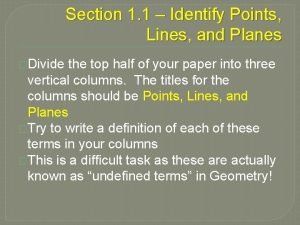7 1 Points Lines and Planes Warm Up
























- Slides: 24

7 -1 Points, Lines, and Planes Warm Up Problem of the Day Lesson Presentation Course 2

7 -1 Points, Lines, and Planes Bell Ringer 01 -03 How did you use math over break? Course 2

7 -1 Points, Lines, and Planes Learn to identify and describe geometric figures. Course 2

7 -1 Points, Insert Lesson Title. Planes Here Lines, and Vocabulary point line ray line segment plane congruent Course 2

7 -1 Points, Lines, and Planes A point is an exact location in space. It is usually represented as a dot, but it has no size at all A line is a straight path that extends without end in opposite directions. point A Use a capital letter to name a point. • A X Y XY, or YX Use two points on the line to name a line. Helpful Hint A number line is an example of a line. Course 2

7 -1 Points, Lines, and Planes A ray is a part of a line. It has one endpoint and extends without end in one direction. A line segment is part of a line. or a ray that extends from one endpoint to another. Course 2 G L H M GH Name the endpoint first when naming a ray. LM, or ML Use the endpoints to name a line segment.

7 -1 Points, Lines, and Planes A plane is a perfectly flat surface that extends infinitely in all directions. Q S R plane QRS Use three points in any order, not on the same line, to name a plane. Helpful Hint A coordinate plane is an example of a plane. Course 2

7 -1 Points, Lines, and Planes Additional Example 2: Identifying Line Segments and Rays Identify the figures in the diagram. M N O A. three rays MN, NM, MO Name the endpoint of a ray first. B. two line segments Use the endpoints in any order to name a segment. MN, MO Course 2

7 -1 Points, Lines, and Planes Figures are congruent if they have the same shape and size. If you place on top of the other, they match exactly. Line segments are congruent if they have the same length. Tick marks are used to indicate congruent line segments. In the illustration below, segments that have the same number of tick marks are congruent. Line segments AB and BC are congruent (one tick mark), and line segments MN and OP are congruent (two tick marks). B 20 m A Course 2 16 m N 20 m C 5 ft 3 ft M O 3 ft 8 ft P

7 -1 Points, Lines, and Planes Additional Example 3: Identifying Congruent Line Segments Identify the line segments that are congruent. A AB CD One tick mark AC BD Two tick marks BF DF EC E AE Three tick marks F C Reading Math The symbol means “is congruent to. ” Course 2 B D

7 -1 Points, Insert Lesson Title. Planes Here Lines, and Try This: Example 3 Identify the line segments that are congruent. A B C D E Course 2 AB AC One tick mark BC DE Two tick marks BD CE Three tick marks

7 -2 Angles Warm Up Problem of the Day Lesson Presentation Course 2

7 -2 Angles Insert Lesson Title Here Vocabulary angle vertex right angle acute angle obtuse angle straight angle complementary angles supplementary angles Course 2

7 -2 Angles An angle is formed by two rays with a common endpoint. The two rays are the sides of the angle. The common endpoint is is the vertex. A Vertex 1 B C You can name an angle in three ways: • with the capital letter at the vertex: • with the number inside the angle: B, 1, • with three capital letters so that the letter CBA at the vertex is in the middle: ABC or Course 2

7 -2 Angles are measured in degrees (°). You can use a protractor to measure an angle. The measure of Course 2 XYZ is 122°, or m XYZ = 122°.

7 -2 Angles Additional Example 1 A & 1 B: Identifying Angle Measures Give the measurement of each angle. A. STV m STV = 55° B. Course 2 XTU m XTU = 25°

7 -2 Angles Additional Example 1 C &1 D: Identifying Angle Measures Give the measurement of each angle. C. WTU m WTU = 40° + 25° m WTU = 65° D. STX m STX = 55° + 60° + 40° m Course 2 STX = 155°

7 -2 Angles An angle’s measure determines the type of angle it is. A right angle is an angle that measures exactly 90°. The symbol indicates a right angle An acute angle is an angle that measures less than 90° An obtuse angle is an angle that measures more than 90° but less than 180° A straight angle is an angle that measures 180° Course 2

7 -2 Angles Additional Example 2: Classifying Angles Tell whether each angle is acute, right, obtuse or straight. A. B. right angle Course 2 obtuse angle C. acute angle

7 -2 Angles Insert Lesson Title Here Try This: Example 2 Tell whether each angle is acute, right, obtuse, or straight. B. C. A. straight angle Course 2 acute angle obtuse angle

7 -2 Angles If the sum of the measures of two angles is 90°, then the angles are complementary angles. If the sum of the measures of two angles is 180°, then the angles are supplementary angles. Course 2

7 -2 Angles Additional Example 3 A: Identifying Complementary and Supplementary Angles Use the figure to name the following. A. one pair of complementary angles m OMP = 30° and m OMR = 60° Since 30° + 60° = 90°, OMP and OMR are complementary. N Q 60° 90° M R Course 2 P 30° O 60°

7 -2 Angles Additional Example 3 B: Identifying Complementary and Supplementary Angles Use the figure to name the following. B. one pair of supplementary angles m RMO = 60° and N Q 60° 90° m QMO = 90° + 30° = 120° Since 60° + 120° = 180°, RMO and QMO are supplementary. Course 2 M R P 30° O 60°

7 -2 Angles Exit Ticket 01 -03 Use the figure to name the following. A. one pair of complementary angles m OMP = 30° and m NMQ = 60° Since 30° + 60° = 90°, OMP and NMQ are complementary. N Q 60° 90° M R Course 2 P 30° O 60°
 A plane contains at least _____ point/s
A plane contains at least _____ point/s How many planes are there in the diagram
How many planes are there in the diagram Points lines and planes geometry
Points lines and planes geometry Geometry 1-1 points lines and planes
Geometry 1-1 points lines and planes Understanding points lines and planes
Understanding points lines and planes Examples of points lines and planes
Examples of points lines and planes Understanding points lines and planes
Understanding points lines and planes Distance and midpoint quiz
Distance and midpoint quiz Coplanar points
Coplanar points Naming a plane
Naming a plane What is this
What is this How many planes appear in the figure
How many planes appear in the figure 1-2 points lines and planes answer key geometry
1-2 points lines and planes answer key geometry 1-1 understanding points lines and planes
1-1 understanding points lines and planes 1-1 understanding points lines and planes
1-1 understanding points lines and planes Understanding points lines and planes
Understanding points lines and planes Lesson 1-1 understanding points lines and planes
Lesson 1-1 understanding points lines and planes Practice 1-2 points lines and planes
Practice 1-2 points lines and planes Lesson 1-1 points lines and planes
Lesson 1-1 points lines and planes Geometry practice 1-2 points lines and planes
Geometry practice 1-2 points lines and planes Points lines and planes vocabulary
Points lines and planes vocabulary Practice a understanding points lines and planes
Practice a understanding points lines and planes Geometry coach points lines and planes
Geometry coach points lines and planes How many planes appear in the figure?
How many planes appear in the figure? How many planes appear in the figure
How many planes appear in the figure
